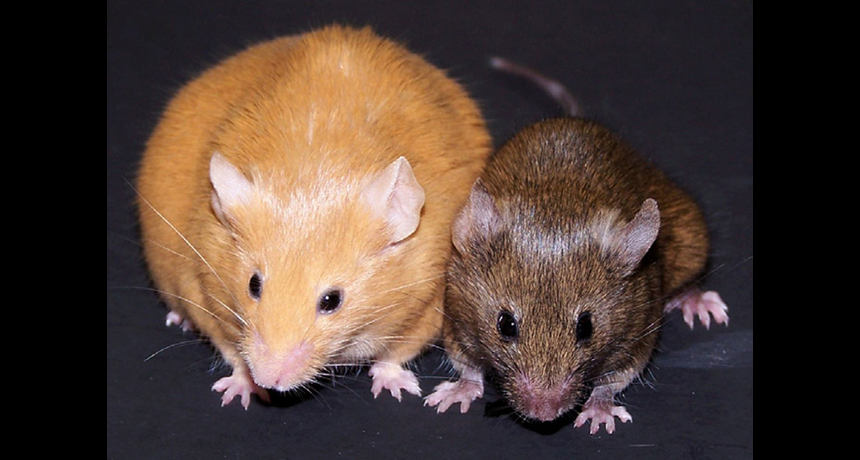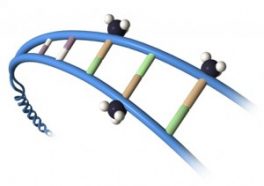What’s on your genes?
Tiny genetic switches create big differences

These two mice are genetically identical and exactly the same age. Each mouse’s mother received a different, specialized diet, which switched on or off chemical clusters called methyl groups that reside near genes. Flipping these genetic switches created differences in size, fur color and health in the otherwise identical offspring.
Randy Jirtle/Duke University
We’ve all heard it before: “It’s in your genes.”
If you’re lucky, a parent or neighbor is trying to explain one of your good quirks, not one of your goofy ones. “Your father could hit the ball out of the park, too,” someone might say. Or you have the same unruly curls as your mom. Thankfully, that someone hasn’t heard you and your dad snore.
But what if it’s not in your genes. What if it’s on your genes?
In 1866, Gregor Mendel showed that pea plants inherit physical and other traits from their parents according to very precise laws of nature. In 1910, Thomas Hunt Morgan showed that genes exist on chromosomes, and in 1952 Martha Chase and Alfred Hershey showed that DNA within a gene carries traits from parent to child. When someone tells you, “It’s in your genes,” they’re saying that the part of your chromosome responsible for your quirk matches that part of the chromosome on your equally quirky parent.
Except when it doesn’t.
Imagine two mice. One looks normal. It’s tiny and brown. The other is fat and has orange fur. The orange mouse not only looks weird, its weight makes it more prone to diabetes and cancer.

The biggest surprise isn’t the differences between these mice — it’s the similarities. The mice have the same DNA in the same order on the same chromosomes. They’re genetically identical. The difference between the mice isn’t in their genes; it’s on them.
Methyl groups — chemical clusters each made of one carbon and three hydrogen atoms — latch onto DNA near a gene. Methyl groups act like switches, turning a gene on or off. In the case of the fat, orange mouse, scientist Randy Jirtle and his colleagues at Duke University used methyl groups to turn off something called the Agouti (a-goo-tee) gene. How? It was pretty simple.
In 2003, Jirtle fed pregnant mice a particular diet that turned off the Agouti gene in the mama mice’s babies. The Agouti gene controls fur color and the feeling of fullness after eating. With the gene switched on, the baby mice grew into orange adults that could never eat enough to be satisfied. As a comparison, the scientists fed a vitamin-rich mouse diet to pregnant mice that were genetically identical to the first group. The Agouti gene was switched off in the babies of those moms who had eaten the vitamin-rich chow. Those pups developed brown fur and a feeling of fullness after eating.
Same genes, different methyl patterns — very different looking mice. Without changing the DNA in the Agouti gene, Jirtle and his colleagues showed the power of what scientists call an epigenetic change.
“Epigenetic literally means ‘above the genes,’” explains Jirtle. Epigenetic changes don’t rewrite DNA, the genetic code. Instead, the activity of the genes is altered. Genes contain the recipe for proteins. Every time a gene is turned on, it makes its particular protein. But how much — if any — of the protein a gene makes and when it makes the protein can be altered by the addition or deletion of methyl groups.
In October 2010, Margaret Morris and her colleagues at the University of New South Wales in Sydney, Australia, took epigenetic research a step further. She showed that babies could inherit epigenetic changes — a scenario never before imagined by geneticists.
“We asked whether the diet of the father might affect his babies,” Morris said.
She took a bunch of healthy, identical male rats and put half on a high-fat diet. The other half ate regular food. Males on high-fat diets became overweight and diabetic (a common complication of obesity in humans). Males on regular diets grew into normal rats. All males mated with genetically identical females who had been raised on a standard rodent diet. Later, Morris examined the daughters of these rats. Would the obese fathers’ weight problems affect their offspring? Nothing learned from Mendel and his peas would make scientists expect that it would.

But Mendel and his peas don’t tell us about epigenetics.
Morris found that none of the rat daughters developed a weight problem, which isn’t surprising given what we know about standard genetics. However, daughters of fat dads did develop health problems related to obesity.
“Female baby rats looked as though they were on their way to becoming diabetic. They couldn’t produce enough insulin,” explains Morris.
Insulin is a hormone needed for the body to use glucose — also known as blood sugar. Glucose is the body’s energy source. A shortage of insulin or the body’s inability to use insulin effectively causes diabetes, a very serious disease.
Genetic changes clearly didn’t cause the daughters’ insulin problems, because the scientists had used genetically identical rats. Instead, fat dads created sperm cells with different methyl patterns on their DNA. Daughters inherited their father’s epigenetic changes. And because of changes in methyl patterns on the genes, daughters also inherited their dads’ health problems.
Foods that our parents eat before we’re born or while we’re still inside the womb can affect epigenetic switches. Smoking, drinking alcohol and aging can all cause epigenetic changes too.
But can behavior create epigenetic changes? Michael Meaney and his colleagues at McGill University in Montreal answered that question in 2004 with rats.
Some mother rats lick their babies a lot. Other mothers ignore their babies. Different kinds of mothering cause babies to become different kinds of adults. No one thinks adult rats remember whether their mothers licked them. But research has shown that licked babies grow up to be braver in the face of stress. Ignored babies are more scared as adults.
As Meaney suspected, epigenetics played a role in this difference. The scientists found distinct differences between methyl patterns in the brain cells of licked babies and those of unlicked babies. The mother’s licking flipped switches on the baby’s gene that shapes how rats respond to stress — showing that the behavior of one animal can sculpt the epigenetic clay of another animal.
But Meaney and his colleagues didn’t stop there.
The scientists believed they could flip gene switches on fearful rats, causing them to become brave. And in 2007, the scientists discovered they were right. By injecting a chemical into rats, the scientists wiped out the animals’ methyl markers and changed rat behavior. Scared rats became brave.
The ability to chemically flip methyl switches can help treat human diseases. For instance, doctors can cure specific forms of leukemia (cancer of the blood or bone marrow) by using chemicals to flip methyl switches. Other scientists, including Randy Jirtle, are exploring the role of epigenetics in diseases like schizophrenia (an illness marked by deterioration of the thought processes), depression (an illness characterized by a feeling of such sadness that the sufferer can’t live a normal life) and autism (an illness that makes it difficult to communicate with other people).
Jirtle explains, “I want to find the genes in humans that are involved in brain development, which, as a consequence, are involved in just about every neurological disorder we have.” And once Jirtle finds the genes, he’ll look for the methyl groups that affect them. He believes he may find cures this way.
So why are gene switches so flippable? Maybe the answer lies in common sense rather than in lab studies. Think of this: Environments change constantly — forests change to grasslands, and grasslands change to deserts. Environments within and around our cells change, thanks to parasites and viruses. Social environments change too: A nurturing environment can become hostile with a stroke of bad luck. No matter how we look at it, humans and other organisms live in constantly changing environments.
On the other hand, an organism’s genome — or set of genetic instructions — doesn’t change quickly. For example, humans now look a lot like humans from 200,000 years ago, even though parents pass on a jumbled mixture of genes to their offspring. How does something as steady as a genome cope with something as changeable as the environment? Perhaps epigenetics is the answer.
Moshe Szyf at McGill University says that epigenetics may offer a way to help our unchanging genes cope with sudden changes in their, or our, environment.
Changing what’s on our genes appears to be easier than changing what’s in them. And that may help explain how life so readily adapts to our ever-changing environment.
Power words
gene: A segment of DNA that codes, or holds instructions, for a protein. Offspring inherit genes from their parents. Genes influence how an organism looks and behaves.
DNA: Short for deoxyribonucleic acid. DNA consists of four main components called nucleotides. These nucleotides are: A (adenine), T (thymine), C (cytosine) and G (guanine). As the nucleotides pair together in long chains, they form a double helix shape, which resembles a twisted ladder.
chromosome: A single piece of coiled DNA found in a cell’s nucleus. A chromosome is generally X-shaped in animals and plants. Some segments of DNA in a chromosome are genes. Other segments of DNA in a chromosome are landing pads for proteins. The function of other segments of DNA in chromosomes is still not fully understood by scientists.
diabetes: A disease caused by the body’s inability to make or properly use insulin, an important hormone.
insulin: A hormone made by the human body that takes glucose, or sugar, from the blood and stores it in the liver and muscles.
glucose: Also known as blood sugar. Glucose provides the body with energy.
sperm cell: Male reproductive cells.
neurological: Having to do with the body’s nervous system, which receives and transmits information. The brain and the spinal cord are part of the nervous system.







